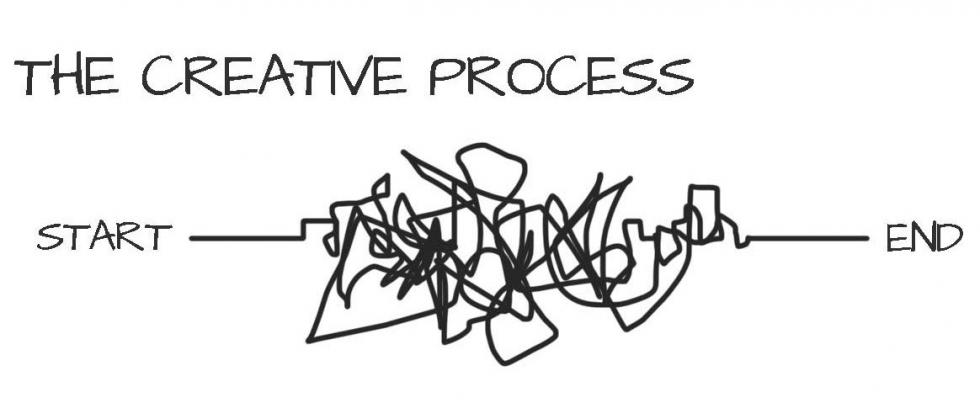

I came across an old absurdist joke recently. ‘Q. How many elephants does it take to change a lightbulb? A. None, elephants can’t change lightbulbs stupid’. As daft as it is, it has taken on a new meaning for me because I've realised what the elephant represents, why he can’t change the lightbulb and more importantly why he can’t switch it on. Allow me to explain.
The elephant is a big one and he’s in the room and I see him daily. He goes by the name of The Creativity Myth. The myth perpetuates the idea of creativity as a mysterious force, a special ability that only exists in ‘creative types’, embodied in the vision of the lone genius. It’s not uncommon to hear people with sharp, inquisitive minds sell themselves short with the words ‘don’t ask me I’m not creative’ which is a great shame. The myth erodes confidence in people’s creative abilities as it's based in such a narrow assumption of what creativity really is. I think the problem starts with the way in which great works of art influence us from an early age and the perceptions we build of their authors as geniuses. From the prodigious output of Mozart and Picasso to the wild invention of Jimi Hendrix we quickly become seduced by the powerful sensory allure of their creative product, deluded in the premise that their art just burst out of their heads as a result of their unfathomable talents. Along the way we have aligned the notion of creativity with free artistic self-expression only, ignoring the many facets of creative thinking that fuel innovation in every aspect of daily life.

Living in a world of constant change, a better understanding of the mechanics of how creativity works has never been so important. A recent survey of top global CEO’s reported that the leadership quality they valued most is the ability to solve problems creatively. Even as technology surpasses the human ability to process large amounts of information, solve complex problems and decipher and predict our likes and dislikes, there’s unique human element to creativity that machines find difficult to replicate. You can feed hundreds of old funk samples into as many clever algorithms as you like but you still won’t get hip hop or robots that can rap!
Creativity is all about the ability to see the world in new ways, make connections, find connections between unrelated ideas, generate solutions and bring something new and valuable into the world. Looking at creativity through a problem-solving lens is the key to understanding how it works as a process. Problem solving suffers from the perception of it being a linear, left brain analytical activity. However, to come up with new ideas of any kind there is an interplay between logic and intuition, a process of absorbing knowledge, questioning assumptions, experimenting, synthesising information and looking at things from new perspectives. A sometimes frustrating and intense iterative cycle that takes hard work and practice to generate results. The antithesis of the creativity myth.

Great creative solutions are not generated in a vacuum; this is why the idea of a blank canvas can be intimidating for many as it’s a fairly impoverished place to start. Jimi Hendrix didn’t just spring out of nowhere wearing a feather boa rocking dynamite riffs. He spent years practicing hard on the road with rhythm and blues and soul bands working within and pushing against the boundaries of their musical structures, learning, always looking for small changes he could make, absorbing new influences into his repertoire, turning his amplifier up too loud and finding out it sounded pretty cool. He slowly discovered he could build a new sound that had never been heard before by making connections between all these influences. Every innovator stands on the shoulders of giants. Perhaps the 60s acid played its part too!

A visualisation method I use when thinking about the process of creating an idea is the metaphor of star gazing, searching out new shapes and constellations that might suggest stories in an huge expanse of tiny lights. Just as our ancestors did before computers! It's a process of looking to make sense and put some order and meaning on a seemingly infinite range of possibilities by making connections. Joining the dots. Each dot is a valuable input, ensuring I'm never starting from a blank canvas. The dots take many shapes and sizes and play a part in influencing the outcome- part of a brief, a memory, a scene from a film, a feeling, a story, a sound.... The best ideas happen when those influences aren't all other creative executions (I'm looking at you Pinterest board!) The point is that the more inputs I put in, the more diverse I make them, the more I observe them, rearrange them and look at them from a new angle, the more connections I make - the more chance I have of a good idea coming out the other end. It’s my way of transforming the elephant into a unicorn!

Jon Humphreys
07 September 2016